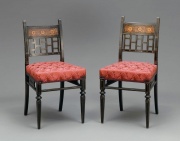Difference between revisions of "Marquetry"
m (Text replace - "== Authority ==" to "== Sources Checked for Data in Record ==") |
|||
| (4 intermediate revisions by 2 users not shown) | |||
| Line 1: | Line 1: | ||
| − | [[File:1996.216-CR9702-d1.jpg|thumb|]] | + | [[File:1996.216-CR9702-d1.jpg|thumb|Side chairs<br>MFA# 1996.216]] |
== Description == | == Description == | ||
| − | + | [[File:2001.562.jpg|thumb|Straw marquetry on chest<br>MFA# 2001.562]] | |
| − | A decorative inlaid pattern made from thin layers of [ | + | A decorative inlaid pattern made from thin layers of [[wood|wood]], [[ivory|ivory]], [[metal|metal]], [[mother-of-pearl|mother-of-pearl]], [[straw|straw]], or [[tortoiseshell|tortoiseshell]], veneered to another surface, usually furniture. Wood marquetry techniques were developed in Antwerp in the early 17th century then imported to France where elaborate luxury pieces were made with very intricate patterns. By the 18th century, workshops in northern Europe and England were known for this specialized technique. The simplest marquetry uses two different color sheets of veneer, temporarily fastened together then cut into a pattern with a fine saw. This created two contrasting panels of identical design (in French called partie and contre-partie, "part" and "counterpart"). Marquetry using colored straw was a specialty of some European spa resorts from the end of the 18th century. |
| − | + | [[File:2001.562a.jpg|thumb|Damage to straw-work marquetry on MFA# 2001.562]] | |
| − | + | See also [[niello|niello]], and [[pietre%20dure|pietre dure]]. | |
| − | |||
| − | |||
== Synonyms and Related Terms == | == Synonyms and Related Terms == | ||
inlay; intarsia; marqueterie (Fr.); mfurniturearketierte (Deut.); markieteria (Pol.); marquetería (Esp.); tarsia (It.) | inlay; intarsia; marqueterie (Fr.); mfurniturearketierte (Deut.); markieteria (Pol.); marquetería (Esp.); tarsia (It.) | ||
| − | |||
| − | |||
| − | |||
| − | |||
== Additional Images == | == Additional Images == | ||
| − | |||
<gallery> | <gallery> | ||
| − | File: | + | File:SC441328.jpg|thumb|Casket with marquetry<br>MFA# 40.234 |
| − | File:40.234 detail and X-Ray.jpg| | + | File:40.234 detail and X-Ray.jpg|Detail and X-ray of marquetry on MFA# 40.234 |
</gallery> | </gallery> | ||
| + | ==Resources and Citations== | ||
| + | * P.Ramond, R. Bonnefond, 'La marqueterie' Metiers d'art, 27 (no. 26), October 1984.° | ||
| − | + | * Patrick Edwards, 'Current trends in conservation of marquetry surfaces' Postprints of the Wooden Artifacts Group (AIC), 1997. | |
* Hermann Kuhn, ''Conservation and Restoration of Works of Art and Antiquities'', Butterworths, London, 1986 | * Hermann Kuhn, ''Conservation and Restoration of Works of Art and Antiquities'', Butterworths, London, 1986 | ||
| − | * Wikipedia | + | * Wikipedia: http://en.wikipedia.org/wiki/Marquetry (Accessed Nov. 9, 2005) |
* Random House, ''Webster's Encyclopedic Unabridged Dictionary of the English Language'', Grammercy Book, New York, 1997 | * Random House, ''Webster's Encyclopedic Unabridged Dictionary of the English Language'', Grammercy Book, New York, 1997 | ||
Latest revision as of 13:37, 17 October 2022
Description
A decorative inlaid pattern made from thin layers of Wood, Ivory, Metal, Mother-of-pearl, Straw, or Tortoiseshell, veneered to another surface, usually furniture. Wood marquetry techniques were developed in Antwerp in the early 17th century then imported to France where elaborate luxury pieces were made with very intricate patterns. By the 18th century, workshops in northern Europe and England were known for this specialized technique. The simplest marquetry uses two different color sheets of veneer, temporarily fastened together then cut into a pattern with a fine saw. This created two contrasting panels of identical design (in French called partie and contre-partie, "part" and "counterpart"). Marquetry using colored straw was a specialty of some European spa resorts from the end of the 18th century.
See also Niello, and Pietre dure.
Synonyms and Related Terms
inlay; intarsia; marqueterie (Fr.); mfurniturearketierte (Deut.); markieteria (Pol.); marquetería (Esp.); tarsia (It.)
Additional Images
Resources and Citations
- P.Ramond, R. Bonnefond, 'La marqueterie' Metiers d'art, 27 (no. 26), October 1984.°
- Patrick Edwards, 'Current trends in conservation of marquetry surfaces' Postprints of the Wooden Artifacts Group (AIC), 1997.
- Hermann Kuhn, Conservation and Restoration of Works of Art and Antiquities, Butterworths, London, 1986
- Wikipedia: http://en.wikipedia.org/wiki/Marquetry (Accessed Nov. 9, 2005)
- Random House, Webster's Encyclopedic Unabridged Dictionary of the English Language, Grammercy Book, New York, 1997
- The American Heritage Dictionary or Encarta, via Microsoft Bookshelf 98, Microsoft Corp., 1998




